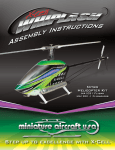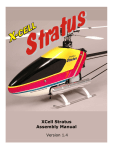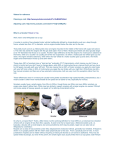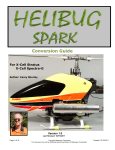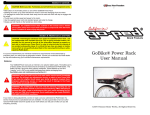Download Spectra G Operating manual
Transcript
Operators Guide #125-100C miniature aircraft usa 31713 Long Acres Drive Sorrento, FL 32776 Phone (352)-383-3201 FAX (352)-383-3204 Website: www.miniatureaircraftusa.com E-Mail: [email protected] 3-D XCell Spectra-G Model – Additional Operators Guide Page 2 of 16 Copyright Miniature Aircraft USA 12/5/2004 XCell Spectra-G Model – Additional Operators Guide Table Of Contents 1. INTRODUCTION................................................................................................................................. 4 2. SO WHAT DO YOU NEED TO KNOW? ........................................................................................... 4 3. SETUP GUIDELINES ......................................................................................................................... 6 3.1. 3.2. 3.3. 3.4. 3.5. 3.6. 3.7. 3.8. 3.9. 3.10. 3.11. 3.12. 3.13. 3.14. 3.15. 3.16. 4. FUEL SYSTEM ............................................................................................................................... 6 EXHAUST SYSTEM ........................................................................................................................ 6 AIR FILTER.................................................................................................................................... 7 SPARK PLUGS............................................................................................................................... 7 INITIAL CARBURETOR SETUP – ZENOAH G231 ............................................................................. 7 THROTTLE SETUP ......................................................................................................................... 8 THROTTLE GOVERNORS ............................................................................................................... 8 ROTOR BLADES ............................................................................................................................ 9 HEAD DAMPING ............................................................................................................................ 9 PITCH CURVES ............................................................................................................................. 9 ANTENNA ROUTING....................................................................................................................... 9 RECEIVER CRYSTALS ................................................................................................................... 9 CARBURETOR MOUNT BOLTS ....................................................................................................... 9 SERVO SUPPORT BRIDGES ......................................................................................................... 10 MUFFLER MOUNTING .................................................................................................................. 10 W IRE CONNECTORS ................................................................................................................... 10 OPERATING GUIDELINES ............................................................................................................. 11 4.1. FUEL ........................................................................................................................................... 11 4.2. OIL ............................................................................................................................................. 11 4.2.1. Oil for Engine Break-In .......................................................................................................... 11 4.2.2. Oil for Normal Operation ....................................................................................................... 11 4.2.3. Excessive Oil.......................................................................................................................... 11 4.3. OPERATION DURING BREAK-IN ................................................................................................... 12 4.4. NORMAL OPERATION .................................................................................................................. 12 4.4.1. Normal Carburetor Settings.................................................................................................... 12 4.4.2. Mixture Troubleshooting ........................................................................................................ 13 4.4.3. Hover Settings........................................................................................................................ 13 4.4.4. Full Power Settings ................................................................................................................ 14 4.5. STOPPING THE MOTOR ............................................................................................................... 14 4.6. ENGINE/MUFFLER HEAT ............................................................................................................. 14 4.7. COOLING THE ENGINE ................................................................................................................ 14 5. TROUBLESHOOTING ..................................................................................................................... 15 Page 3 of 16 Copyright Miniature Aircraft USA 12/5/2004 XCell Spectra-G Model – Additional Operators Guide 1. Introduction This document is provided as an addendum to the standard instruction guide for the XCell Spectra-G. This guide is based on the experiences of our design team and is intended to help our customers with the setup/operation of the model when using a Zenoah G231 engine. Due to the flexible design of the model, other brands/types of engines may be used however this document and its contents are focused on use of the Zenoah engines. 2. So What Do You Need to Know? The instructions are very thorough concerning the construction and setup of this model. Please follow them as written. The content of this guide will address questions that may come up as you get ready to fly your new XCell Spectra-G model. a) I’m new to gasoline powered models, what can I expect to be different from a glow powered model? Other than the fuel, sound and smell, it will operate pretty much like any other powered helicopter. Once properly adjusted, the model will fly almost 30 minutes on a tank of gas. There will always be some vibration. The nature of large single cylinder motors is that they will vibrate some. When properly adjusted and broken-in they will run almost as smooth as glow motors, but never as smooth. Once setup properly though, they will run for a very long time with little attention. It’s not unheard of to have over 100 gallons of fuel through these motors with just normal maintenance. That’s a lot of flying time. As with glow motors, when the correct setup and mixture has been reached, the model will have a particular sound and behavior. This can’t really be better explained, but over time you will get used to hearing it and realize when it has changed. The model is heavier than a standard glow model, so it will fly heavier. It will be steadier in a hover, especially when it’s windy and will react slightly slower to massive pitch changes. This doesn’t affect WHAT the model will do, only they way in which it does it. b) Is there any special setup that may be required? The instructions provided with the kit do a good job of covering the assembly. There are some additional recommendations in this manual in the section that follows entitled “Setup Guidelines”. c) What do I need to know before starting the model for the first time? Follow all the instructions about assembling the model and setting up the electronics. Then read the section “Operating Guidelines” that follows. There is enough information here to make the model work properly. Page 4 of 16 Copyright Miniature Aircraft USA 12/5/2004 XCell Spectra-G Model – Additional Operators Guide d) So what do I need to start this model? The Zenoah motors are supplied with a pull starter. This can be permanently mounted or made removable. This is one way to start the motor. In addition, you can use a standard spin starter on the start shaft above the clutch. The G231/G26 motors can be started in this method using a typical starter for .90 size glow motors and the Pro-Flex starter wand. This works so well, it is the recommended method. e) So how do I go about starting the model? Develop a routine and follow it every time: Depress the primer bulb on the carburetor until there are no bubbles or air in the fuel line. This will take a few pumps. Make sure the throttle is set at the starting position, about 10% open from full closed. You may need to adjust the throttle trim as necessary. If you’re using a pull starter, the engine will need to be choked (by closing the choke lever) and pulled through 4-5 times. Then open the choke and the motor should start with 1-2 pulls. If you’re using the recommended spin starter, you won’t need the choke. Always hold on to the rotor head with one hand when starting the motor to prevent it from accidentally hitting you. Any time that the motor has been sitting for a few hours, it will idle at a much higher RPM than the trim is set for. As the motor warms up, it will slow down and settle in to an idle. The clutch has been designed to allow for this. It is a normal part of the startup routine. If the motor does not start and you have set the mixture to the initial settings try increasing the idle trim slightly, however do not increase too much or the model may start and get away from you. f) What if I have problems? First, look at the section “Troubleshooting” that follows in this document to see if your questions are answered. If your situation is not covered, then contact Miniature Aircraft USA via their Technical Support forum on the website (this forum is monitored regularly by the design team who will be happy to help), via e-mail or call the shop. Page 5 of 16 Copyright Miniature Aircraft USA 12/5/2004 XCell Spectra-G Model – Additional Operators Guide 3. Setup Guidelines The following tips will ensure that the engine and model have been configured for best results. These are of course not the only way to do things however these have been repeatedly proven to work. 3.1. Fuel System Follow the assembly manual for installing the fuel system. This will result in three fuel lines to the tank • A vent line • A primer bypass from the top of the carburetor • A fuel feed from the carburetor This configuration will apply regardless of tank location. Use only fuel line compatible with gasoline products. The kit includes Tygon fuel line, which can be obtained from MA USA or your local hobby store. As per the instructions, it is preferable that the line used as the fuel feed remains as one piece. The addition of any filters or “T” fittings into this line can trap air bubbles that will later enter the fuel inlet and may cause the engine to hesitate during flight. Keeping the fuel feed line as one continuous piece will eliminate this possibility. The included filter must be installed in the fuel tank. To remove any unused fuel from the tank, we suggest you simply remove the fuel line from the carburetor fuel inlet and pump it out through that tube (you will need to remove the plug on the vent line to do this) As delivered from the gas station pump, gasoline is not particularly clean. It is often contaminated with particles of one sort or another. The kit is delivered with a very fine fuel filter to minimize the chance that these fuel contaminates can enter the carburetor. Several different filters were tested and this particular one offered excellent fuel pickup. You may of course use other types of filters although most of the standard glow-fuel filters do not adequately filter gasoline because the filter elements are too coarse. The fuel vent line is capped with a one way air valve. It is important that this valve remain in place. The Zenoah carburetor contains a fuel pump that will pull fuel from the tank. If the tank is not vented, it will collapse from the vacuum that forms and eventually cause the engine to stop running. However an open vent line can allow raw gasoline to run out of the vent line if your flying style includes inverted flight. The one-way valve allow the tank to vent, but will prevent fuel from escaping. It also requires that the capped “T” fitting be including in this vent to allow the tank to be filled normally, since otherwise trapped air could not escape during fueling. 3.2. Exhaust System Miniature Aircraft has tested several different exhaust systems for use with this gas model. a) The Zenoah muffler that comes as standard equipment with the motor, while not having an appealing sound, will work fine and result in a cooler running engine. b) In conjunction with MA, Hatori has developed a muffler for use with the Zenoah G23/G231/G26 engines. Miniature Aircraft recommends this muffler, which was specifically designed for use with this helicopter. It is significantly quieter and allows a broad power curve. Page 6 of 16 Copyright Miniature Aircraft USA 12/5/2004 XCell Spectra-G Model – Additional Operators Guide c) In addition, GoPed manufacturers offer a number of mufflers for use with the G231 on scooters. Some of these have been tested and work acceptably. Most of these are quite a bit heavier than either the stock muffler or the Hatori. 3.3. Air Filter It is recommended that an air cleaner always be used with an installed Zenoah engine. At full operating RPM, the engine is using a lot of air and is more prone to pick up contaminants from the air. This will affect the long-term health of your new motor. 3.4. Spark Plugs MA recommends using the standard spark plugs that are shipped with the Zenoah motors. These have proven to run very well. Replacement plugs of this type are available from various sources. Regardless of the manufacturer, a resistor spark plug (R designation) MUST BE USED WITH THIS HELICOPTER. Failure to use a resistor plug will result in loss of control of the model due to RF interference from the ignition system. Although not required, it is recommended that you purchase the RF Reduction Kit - MA Part # 125-114. This will eliminate any potential ignition noise. 3.5. Initial Carburetor Setup – Zenoah G231 As an initial setup, use these settings depending upon the carburetor type. The Walbro carburetors have the model number stamped on the carburetor body near the fuel inlet. These settings are based on average altitude above sea level. High altitude operation will require different settings. They apply to the stock motor only. If you are using the optional high performance motor, follow the instructions included with the motor The adjustment of either the high speed or low speed needles works as follows: Leaner Mixture – close needle – turn clockwise Richer Mixture – open needle – turn counter-clockwise Note: There has been a lot written about which carburetor to use with the Zenoah G231 motor. Depending on where you acquire it, it may use the Walbro WT677 or WT643 carburetor. We have provided settings for both carburetors however MA recommends the use of the WT643 carburetor for best results. 3.5.1.Walbro WT-677 Low Speed: High Speed: 1-2/3 turns open from full closed 1-1/8 turns open from full closed 3.5.2.Walbro WT-643 Low Speed: High Speed: 1-1/2 turns open from full closed 1-1/2 turns open from full closed Page 7 of 16 Copyright Miniature Aircraft USA 12/5/2004 XCell Spectra-G Model – Additional Operators Guide 3.6. Throttle Setup Make sure the idle position screw has been backed out such that the throttle butterfly can close completely without touching the idle screw. Also make sure the return spring has been unhooked from the carburetor body. Its tension will put undue force on the servo which is unnecessary. As per the kit instructions, the carburetor throttle arm should have been installed so that it will be exactly at 90 degrees to the engine at ½ throttle. This is at the optimum position for best throttle control. Install the servo ball link at 13mm from the center of the servo. This will allow full deflection of the servo and throttle at 100% travel in each direction which will allow the best control resolution of the throttle. A good initial throttle curve is as follows (this assumes 0% is throttle closed fully) Five Point Curve 1 2 3 4 5 10% 25% 50% 75% 100% If your radio supports more than 5 points, match the low, middle and high points and then interpolate all points in between. This is just a starting point, you will need to adjust this curve for your particular combination of rotor blades and pitch curves to match your RPM requirements. 3.7. Throttle Governors Throttle governors work very will with the recommended throttle setup. Although there are several on the market, extensive testing has been done with the Futaba GV-1. Use a throttle servo recommended by the governors manufacturer for compatibility, although faster is better. Regardless of manufacturer, all of the governors require a magnet and pickup be mounted, usually in the fan. On a gas model, this is particularly difficult to complete because there are not standard mount points for the sensor. MA recommends the use of the Stator Gator optical pickup for use with the GV-1. This device can simply be plugged into the “black” wire from the engine ignition system on the G231 and G26. It has proven to work very well and is simple to install. The wires on the stator gator are long enough that the unit can be mounted easily; however make sure they are secured to prevent them from being eaten by the drive train. The Stator Gator control location is not critical as it will not cause any radio interference. Follow the governor manufacturer’s instructions for setup of the unit itself. Make sure you use the correct gear ratio. The stock gear ratio is 7.15:1. Page 8 of 16 Copyright Miniature Aircraft USA 12/5/2004 XCell Spectra-G Model – Additional Operators Guide 3.8. Rotor Blades Rotor blades are a personal choice and you will choose the type and weight of rotor blade that best fits your flying style. Experience has shown that the following rotor blade lengths provide the best results with this model: Standard Rotor Head – 710mm rotor blades Tempest Rotor Heads – 700 mm rotor blades 3.9. Head Damping Follow the instructions concerning the initial head damping options. You will probably adjust this according to your personal flying style however keep in mind that this model is heavier than our other models, so in general stiffer damping will be needed to maintain proper head response. Use at least the 60 durometer dampers. 3.10. Pitch Curves Follow the pitch curve setup instructions provided in the instruction guide. There is a misconception that pitch curves should be set at higher pitches with gasoline motors because of their additional torque. This is a misconception and should not be followed. Excessive high and low main rotor pitch will un-necessarily load the engine. Set the initial high and low pitch settings at no more than +10 degrees and –10 degrees. After the motor is broken in, you may experiment with other settings however be careful to not excessively load the motor at extreme pitch ranges. 3.11. Antenna Routing The model has been tested with both whip and full length wire antennas and both have worked adequately. It is recommended to use the full length wire antenna and use the provided antenna routing materials and path found in the instructions. These are known to work properly and minimize the chance of RF interference from the ignition system. 3.12. Receiver Crystals It is recommended that you secure the crystal for your receiver with a piece of tape. This will prevent it from eventually vibrating loose. If the crystal should become loose, it will result in loosing radio control of the model. 3.13. Carburetor Mount Bolts When installing or re-installing the carburetor, do NOT over-tighten the bolts that hold the carburetor to the mounting block. The mounting block contains metal nuts and if the bolts are too tight it can cause the isolator block to crack around these nuts. If the block cracks, it will allow air to leak into the engine and it will run lean. This condition will be very difficult to diagnose and the motor will not run properly until this is corrected. Page 9 of 16 Copyright Miniature Aircraft USA 12/5/2004 XCell Spectra-G Model – Additional Operators Guide 3.14. Servo Support Bridges It is recommended that you purchase the optional servo support bridge package. The model will perform adequately without these however they add a level of security to the servo installation. Without the bridges in place, if the bolts that secure the servos come loose and fall out, the servo will dislodge and perhaps cause the model to crash. With the support bridges in place, several of the servo mount bolts can loosen or fall out and you should still be able to maintain control of the model. 3.15. Muffler Mounting If you have elected to use the optional Hatori Muffler, it is important that you securely mount the components together. When installing the mounting block to the engine, use a hightemperature silicon rtv compound (as an example Permatex Ultra-Black #598B) to secure the bolts to the engine. This will prevent them from loosening and cause the muffler to possibly fall off. Use this to secure all of the threaded components on the muffler. 3.16. Wire Connectors Make sure that all connectors are secure. It is recommended that you use additional security for the battery connectors, especially if you are using extensions or regulator connections. Should these connectors become disconnected or simply fit loosely it will likely result in loss of control of the model. Page 10 of 16 Copyright Miniature Aircraft USA 12/5/2004 XCell Spectra-G Model – Additional Operators Guide 4. Operating Guidelines The following tips are intended to assist in initial flights of your Fury Gas model. As with most things, there are many opinions about what is the “best” setup to use. The following guidelines are not the ONLY way to ensure success however they have consistently provided good results. 4.1. Fuel Miniature Aircraft recommends the use of regular unleaded gasoline (87 octane) with the Zenoah line of engines. These engines are designed to work with low octane gasoline. Using higher-octane fuel will not improve engine performance. These engines have also been tested using white gas (also known as lantern or camper fuel) available at many discount and sporting goods stores. Our field representatives have many hours of flying with this fuel. The primary advantages of using this fuel are that it tends to run cleaner and has fewer odors than gasoline. The Zenoah G231 REQUIRES that pre-mix approved oil is mixed into the gasoline before fueling the model. Follow the Oil guidelines in this document. Failure to mix fuel and oil will cause the engine to fail. 4.2. Oil Miniature Aircraft recommends the use of good quality 2-stroke oil designed to be premixed. For engines other than Zenoah, follow the manufacturer’s instructions for pre-mix guidelines 4.2.1.Oil for Engine Break-In For the Zenoah G23/G231/G26 it is recommended that engine break-in be done using petroleum based oil, mixed at 36:1 ratio. Most of the yard implement oils such as Poulan and Echo are mineral based and will work acceptably. Yamalube 2R has also been used by our pilots with good results. This oil can be found at many motorcycle shops. 4.2.2.Oil for Normal Operation After break-in, either a petroleum or synthetic based oil may be used. Synthetic oils will allow a higher mix ratio. If you’d prefer to use petroleum-based oil, MA recommends Yamalube 2R mixed at a ratio of 42:1 and no higher than 48:1 (This is the oil manufacturer’s maximum limit). If you’d prefer to use synthetic based oil, MA recommends AMSOIL Saber Professional 100:1 Premix mixed at a ratio of 50:1. This oil has been tested at 100:1 without any problems, but MA does not recommend exceeding the 50:1 ratio. The higher ratio doesn’t significantly improve running characteristics and eliminates any margin of error for mixture. A lean run can damage permanently damage the engine. 4.2.3.Excessive Oil It is not recommended that these oil ratios are exceeded by adding more oil. Excess oil will lead to deposits on the piston and cylinder head and can cause the piston ring to lodge in the piston land. Page 11 of 16 Copyright Miniature Aircraft USA 12/5/2004 XCell Spectra-G Model – Additional Operators Guide 4.3. Operation During Break-In Always follow the instructions from the engine manufacturer concerning any special operating procedures for break-in. In general, the model can be operated normally although it is suggested that the rotor head speed be limited to 1650RPM for the first 2-3 gallons of fuel. The break-in period for the Zenoah G23/G231/G26 engines is about 5 gallons of fuel. The engine will gradually break-in and will develop more power and run smoother during that period. During this period, you will gradually be able to lean the carburetor mixture settings to those considered “normal”. 4.4. Normal Operation 4.4.1. Normal Carburetor Settings The exact carburetor settings will vary slightly according to temperature, humidity, altitude and rotor blade size, however between 1 and 1-1/2 turns on each needle will be correct in general regardless of carburetor. Adjust the low-end needle for smooth operation at up to ½ throttle. The low-end needle controls the mixture from throttle closed to ½ throttle with no interaction from the high-end needle (in fact you can close it and the motor will run fine up until the transition point). There is a small portion of throttle travel just above ½ where the setting of the low and high speed needles transition. Above that point, the high-speed needle will significantly affect the mixture. The low speed needle is very sensitive. Make adjustments in very small increments (1/64 turn at a time). Do not make large adjustments to the low speed needle! The high-speed needle is less sensitive and can be adjusted in 1/16 turn increments. The correct low speed setting is when the model will hover cleanly. If the engine is too rich it will not clean out at hover, but instead tend to “four stroke”. This will be very evident, as the tail rotor will tend to “kick” in a hover. If the setting is too lean, the engine will tend to bog (its really starving for fuel) when the throttle is advanced. It will be difficult to get the motor to run fast enough to hover or it will quit running. The correct high-speed setting allows the engine to operate cleanly above ¾ throttle. After break-in the following Needle Settings are typical for these carburetor models installed on a Zenoah G231 engine using the standard gear ratio of the XCell Gas model: 4.4.1.1. Walbro WT-677 Low Speed: High Speed: 1-2/3 turns open from full closed 1 turns open from full closed 4.4.1.2. Walbro WT-643 Low Speed: High Speed: 1-1/2 turns open from full closed 1-3/8 turns open from full closed Page 12 of 16 Copyright Miniature Aircraft USA 12/5/2004 XCell Spectra-G Model – Additional Operators Guide Use of the optional Hatori exhaust system will require the mixture settings to be made slightly leaner, about 1/8 turn on each needle Use of the optional air cleaner system will require the mixture settings to be made slightly richer, about 1/8 turn on each needle. 4.4.2. Mixture Troubleshooting General Observations A good way to double-check the current mixture is to examine the spark plug. Operate the model for about 5 minutes at hover or full power settings, then land, shut off the engine and remove the spark plug. Examine the porcelain nose on the plug for color and observe the following: Black or Very Dark Brown – mixture is very rich, which will result in excess deposits. Recheck the carburetor needles and adjust to normal settings. Continued operation of the motor with this mixture will result in excess piston deposits and can lead to a stuck piston ring. Brown or Light Brown – mixture is correct. Make only minor needle adjustments to resolve any vibration or tail-kick problems Grey or White - mixture is too lean. Continuing to operate at this mixture may result in engine damage. Recheck the carburetor needles and adjust to normal settings. 4.4.3.Hover Settings At hover, when the fuel mixture is correct, the model will be very smooth and the tail rotor will sit nicely. If adjustment is needed, the low speed needle will have the most influence on hover performance. Using the normal settings will be very close to the correct mixture in most climates (not high altitudes). A slightly rich setting will tend to kick the tail rotor and a slightly lean setting will tend to make the helicopter vibrate more. Adjust the low speed needle depending on the circumstances. In addition, using the stock gear ratio provided with the Spectra-G model, at hover a Zenoah motor will be very close to the low/high circuit transition on the carburetor. If you find that the hover mixture is incorrect, (tail kicking or excess vibration) and making small adjustments to the low speed needle has not resolved this, try making VERY small adjustments to the high-speed needle to see if it will improve the engine smoothness at hover. Make sure you know the original setting of the high-speed needle before making adjustments and always use it as a basis for further adjustments. Otherwise the high-speed setting can be unexpectedly changed significantly. Page 13 of 16 Copyright Miniature Aircraft USA 12/5/2004 XCell Spectra-G Model – Additional Operators Guide 4.4.4.Full Power Settings Obviously the only way to determine if the full power setting is correct is to operate the helicopter at full power. If you are unable or uncomfortable with doing this, either get someone who can to operate the model, or simply rely on the normal settings indicated earlier (the will be close enough). To begin with, full throttle/full pitch operation is no different with a gasoline motor as with any other power source. Too much pitch can cause the engine to bog and overheat regardless of fuel mixture. So if the engine bogs significantly at full collective, the first thing to check is the pitch setting. Although this will be dependent on blade length, cord, profile and weight, the engine should be capable of operating at full power with 10 degrees of positive or negative pitch when using blades shorter than 725mm. If mixture adjustments are needed, the high-speed needle is a “fine” adjustment, so changes to the needle itself are less critical. An overly rich high-speed needle will result in causing the engine to 4-stroke at full power and an overly lean setting will result in excess vibration, overheating the engine and perhaps seizing it. Neither situation will result in optimum power. Until you become comfortable with the right “sound” of the model when the mixture is correct, follow this procedure to check the mixture. Operate the model at full power for about 5 minutes, then land, allow the engine too cool and examine the spark plug (see earlier observations). Adjust the high-speed needle accordingly. 4.5. Stopping the Motor To stop the motor in the model, either use the throttle position by closing the throttle fully or if you are holding the model and the air cleaner assembly you are using includes a choke, simply close it. 4.6. Engine/Muffler Heat Be careful!! The motor and the exhaust get VERY hot and will remain hot for longer than you might think. Be careful not to get any flammable material on them when they are hot. 4.7. Cooling The Engine When initially shut down, the temperature of these motors will increase by as much as 75 degrees and then gradually start to cool off. Sometime referred to as “heat soak”, this is simply a normal condition. It is suggested that if possible, let the motor idle for a couple of minutes before shutting it down, especially if the model has been flown hard. By idling the motor just for a minute, it will cool down significantly and there will be less heat soak. Page 14 of 16 Copyright Miniature Aircraft USA 12/5/2004 XCell Spectra-G Model – Additional Operators Guide 5. Troubleshooting The following questions represent some of the most common complaints our design team has encountered in the support of gasoline-powered models. a) When trying to get the motor up to hover speed, the motor bogs and won’t increase in speed or may stop. This almost always means the low speed needle is too lean. Open the low speed needle 1/8th turn and try again. Be careful though, the “initial recommended settings” are going to be very close. b) When trying to start the motor, it won’t start regardless of throttle setting Assuming the motor has fuel, and the spark system is working, the low speed needle may be too lean. Open the low speed needle 1/8th turn and try again. Be careful though, the “initial recommended settings” are going to be very close. Generally, if the motor won’t start it’s because the throttle trim has been set too low, or the low-speed mixture setting is too lean c) When the motor is first started for a flight, there is excess exhaust smoke and the helicopter vibrates. After about a minute of hovering, the smoke stops and the helicopter becomes smooth: This is a normal behavior of these motors. It takes a minute or so to clear out oil residue in the crankcase and for the engine to heat up to correct the working tolerances. d) The motor was running fine and suddenly started to run erratically and won’t settle down: If this condition continues, mostly likely contaminants have gotten in the carburetor orifices. We recommend using a pressurized air or other contact cleaner product to blow them out. First note the exact position of the high and low speed needles then remove the needles and blow them out using the pressurized method. This can be done with the carburetor on or off the model. Then reinstall and adjust the needles to their original settings. If the orifices were contaminated, the model should again run smoothly. If it does not, consider removing the carburetor and checking its internal components for contaminants. Carburetor repair is beyond the scope of this document, however Walbro offers a service guide for their carburetors and repair kits are available for every Walbro carburetor. e) After landing and returning to an idle, the engine is making a clattering sound but is running normally: This doesn’t necessarily mean that there is a problem, but it does mean the motor is VERY HOT and the cylinder clearances have opened up. If the model has been flown very hard, especially on a hot day you can expect this. The motor will cool off after a few minutes of idling or steady hovering. It can also mean that the fuel mixture is too lean. If this continues, examine the spark plug color as indicated elsewhere to make sure the fuel mixture is correct. f) If I use a temperature measuring device, what temperatures are normal: Page 15 of 16 Copyright Miniature Aircraft USA 12/5/2004 XCell Spectra-G Model – Additional Operators Guide With older designed motors, operating temperature was interesting because the models often overheated. The current design G231/G26 motors cool very well. Measurement isn’t really necessary anymore. However if you insist, normal is gong to be hard to define because the measuring devices are typically inaccurate and it will depend on exactly where the reading is taken as to whether or not they will match any other reading. Always use the same measuring device and always measure in the exact same place on the motor. In general terms, when measured on the cylinder head, on the exhaust side, two fins above the exhaust port, the model will hover at a head temp of around 275 degrees Fahrenheit and normal full power operation will be around 350 degrees Fahrenheit. Your readings may be different depending on a lot of variables. The actual number is less important than its relative reading. If it always hovers at 275 degrees and on the next flight it’s running at 375 degrees, then something has changed that you might want to look into. Page 16 of 16 Copyright Miniature Aircraft USA 12/5/2004

















